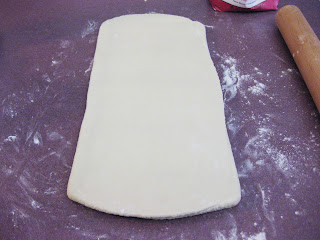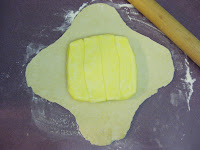 |
| turned dough (read on to find out what that means) |
Plus there's something I love about the sheer magic of making puff pastry. Constructing well over a thousand layers (2,187 to be exact) just by folding the dough and increasing the layers exponentially (scroll down to see the math). It's pretty damn cool.
PUFF PASTRY DOUGH
Yield: approx. 2 lb.
500 g. all-purpose flour (approx. 3 1/2 cups)
75 g. unsalted butter, melted & cooled (approx. 5.3 tablespoons)
2 teaspoons salt
250-280 g. water (approx. 1 cup + 1 to 3 tablespoons)
500 g. cool butter (approx. 1 lb. + 3 tablespoons), not right from the fridge, but not too warm
1. Combine flour, 75 g. butter, salt and water; mix only until thoroughly combined.
2. Form dough into ball. Cut an “X” in the top (helps dough relax and separates it into 4 quarters to help roll into the right shape). Let rest in refrigerator for at least 1 hour. This dough is called the “detrempe”.
3. Sandwich the 500 g. cool butter in between 2 sheets of plastic wrap (shape as close to a square as possible). Flatten & soften by hitting with a rolling pin and shape into a square about 1 ¼” thick. Wrap and keep cool (but still slightly softened).
4. Remove dough from fridge, roll “sides” out thinner than center. Place butter in the center and fold corners over the butter like a package (called a “pâton”); seal well. Roll out and fold to make 3 layers (this is called a "turn"; see the photo at the top of the page). Make one more turn*; let rest for at least 1 hour in the refrigerator.
*After the first turn, give the pâton a 1/4 turn so the opening is to the right or left. This is necessary before each rolling, so the gluten is stretched in all directions—not just lengthwise. If not, the dough will shrink or bake unevenly.
5. Roll and make 2 more turns; rest for at least 1 hour in the refrigerator.
6. Roll and make final 2 turns; rest for at least 1 hour in the refrigerator.
7. Roll, rest and use according to recipe. Can be refrigerated for 3-4 days or frozen for up to 2 months.
|
|
|
|
|
|
|
|
|
|
|
|
Repeat turning and resting according to the recipe.
 |
| rolled and ready to use in whatever recipe you choose (how thin you roll it will depend on what you're making with it) |
Here's the math that gets you to ultimately reach 2,187 layers!
Layers
Pâton has 3 layers (dough, butter, dough)
after 1st turn: 3 x 3 = 9 layers
after 2nd turn: 3 x 9 = 27 layers
after 3rd turn: 3 x 27 = 81 layers
after 4th turn: 3 x 81 = 243 layers
after 5th turn: 3 x 243 = 729 layers
after 6th turn: 3 x 729 = 2,187 layers
The leavening happens 3 ways
Steam: Moisture in the dough (water) and in the butter becomes steam, which pushes the layers apart, separating fat layers from the dough.
Enclosed/Trapped Air: Each time the dough is folded, some air is trapped. These air cells expand during baking and push layers up and apart.
Fat: When the butter is heated, air bubbles form and begin to boil, raising the layers.
Butter is the best fat to use, because of its flavor and melting point. Incorporate evenly throughout the dough. Too warm butter is more difficult to work with. A hot kitchen causes butter to melt too quickly. Too cold butter will puncture the dough. Best results are when the dough and butter are the same temperature and consistency.
Some delicious things you can make with puff pastry: napoleons, turnovers, cheese sticks, palmiers, pies, tarts and an endless variety of hors d'oeuvres.
 |
| raw puff pastry dough |
 |
| baked puff pastry dough (amazing, right?) |
 |
| cross section of the flaky layers |
Some delicious things you can make with puff pastry: napoleons, turnovers, cheese sticks, palmiers, pies, tarts and an endless variety of hors d'oeuvres.















1 comment:
When are you moving closer?
Post a Comment